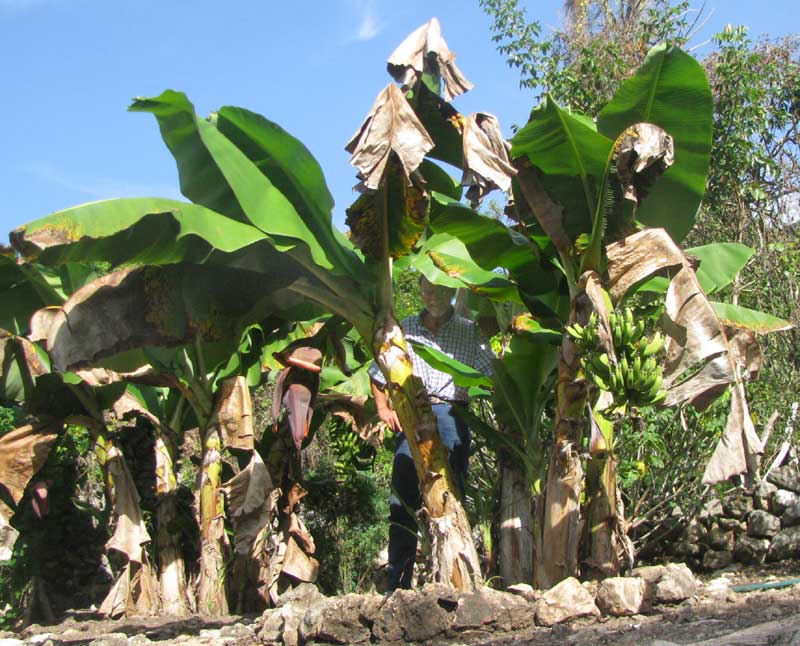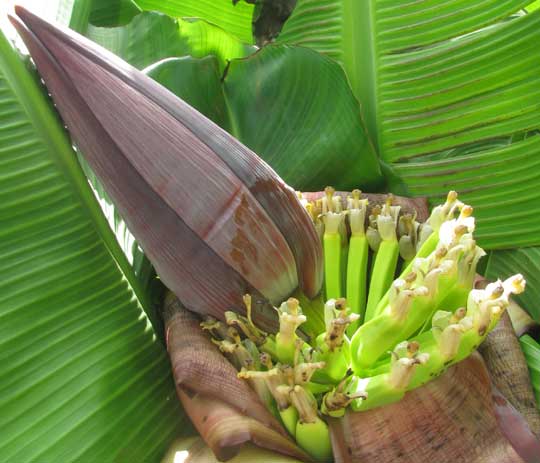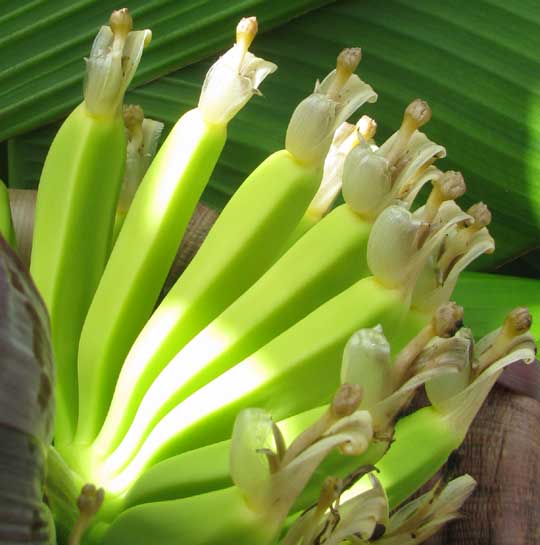Excerpts from Jim Conrad's
Naturalist Newsletter

from the December 18, 2011 Newsletter issued from Hacienda Chichen Resort beside Chichén Itzá Ruins; limestone bedrock; elevation ~39m (~128ft), N20.675°, W88.569°; central Yucatán state, MÉXICO
DWARF BANANA FLOWERS
The common Banana plant, sometimes known as the Plantain, is usually named Musa paradisiaca, and under ideal conditions it can grow up to 30 feet tall (9m). Here we also grow Dwarf Bananas, often known as MUSA NANA, which are much smaller. You can see some in our garden, with me peeping from the shadows, above.
Some of our Dwarf Bananas are just issuing new flower spikes so near the ground that their flowers are easy to see. An emerging spike with female flowers at the base ready for pollination, and male flowers at the top still enclosed in large, purplish bracts, is shown below:

The yellow-green, banana-shaped items at the picture's bottom are the female flowers' ovaries, which eventually will ripen into bananas. The white, papery, cuplike things atop each ovary are calyxes. Corollas are represented by single petals, which aren't distinguishable in the picture. The matchstick-like items jutting from inside the calyxes are globular stigmas atop their styles, which are the ovaries' necks. A close-up better showing the female flowers is below:

One story the above picture tells us is that bananas employ the strategy of having their male and female flowers mature at different times. While the female flowers are in plain view, the male flowers remain hidden behind large, reddish-brown bracts, not yet mature and not yet producing pollen.
Actually, this neat trick for avoiding self- pollination is wasted on bananas, since they've been so single-mindedly selectively bred by humans for so long that under normal conditions banana plants have lost their ability to reproduce sexually. When you slice a banana and see those tiny, dark, sandgrain- like items in the fruit's core, you're seeing aborted ovules. Banana trees are reproduced by offshoots, not seeds. If humans disappear, banana plants will, too.
By the way, with such scrambled genes, banana taxonomy is a mess. Some top experts say that the whole Linnaean concept of the binomial consisting of the genus and species names is inadequate to deal with the banana's heritage. Still, the USDA declares that the Banana Family, the Musaceae, comprises two genera, and the banana genus Musa embraces seven species. Some banana species produce seeds in inedible fruits, and some species are important fiber producers.
Another aside: How do you distinguish a Dwarf Banana from small cultivars of the regular Banana? My old Bailey's Manual states that, among other things, the Dwarf's calyx is 1-1¼ inches long (2.5-3.2cm) while the regular's is 1½-2 inches (3.8-5.0cm). Ours is one inch. Also, the large scales covering a Dwarf's male flowers are "red-brown," while the regular's are "red or violet." Ours could be called red-brown. Therefore: Dwarf.